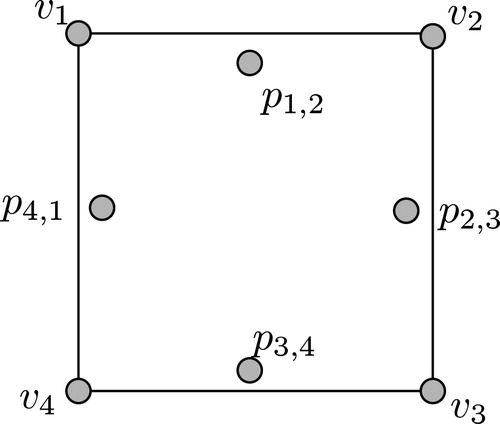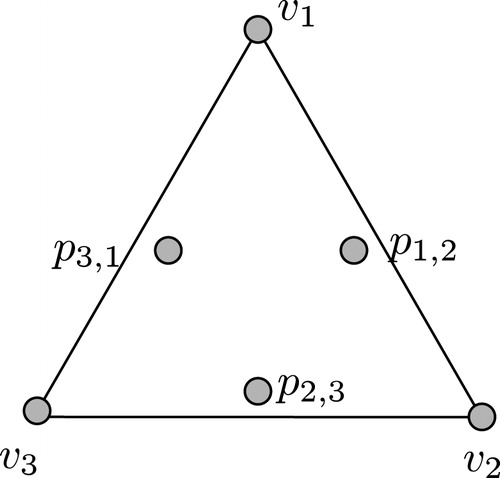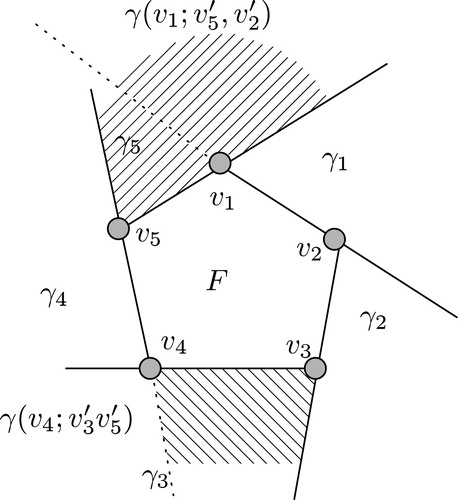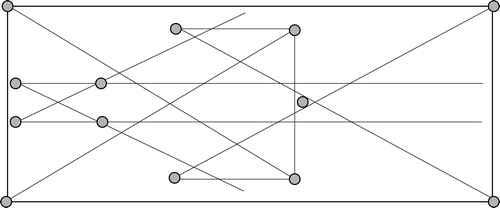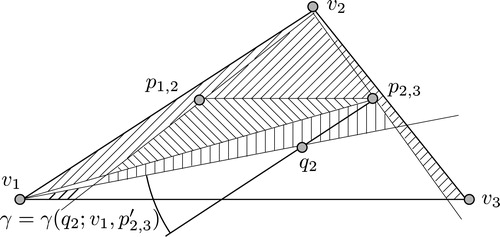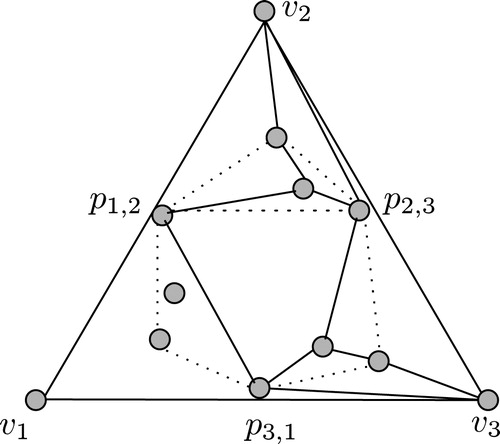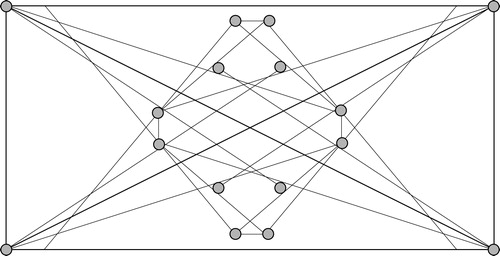 ?Mathematical formulae have been encoded as MathML and are displayed in this HTML version using MathJax in order to improve their display. Uncheck the box to turn MathJax off. This feature requires Javascript. Click on a formula to zoom.
?Mathematical formulae have been encoded as MathML and are displayed in this HTML version using MathJax in order to improve their display. Uncheck the box to turn MathJax off. This feature requires Javascript. Click on a formula to zoom.Abstract
A -hole of a planar point set in general position is a convex
-gon whose vertices are elements of the set and whose interior contains no elements of the set. We discuss the minimum size of a point set that contains specified holes with disjoint interiors.
1 Introduction
In 1935, Erdős and Szekeres [Citation1] stated that for every integer there is a smallest number
such that every set of at least
points in general position in the plane, contains a subset of points that are the vertices of a convex
-gon. The exact value of
is a long standing open problem. A construction due to Erdős and Szekeres [Citation2] shows that
, which is also conjectured to be sharp. It is known that
[Citation3] and
[Citation4]. The best known upper bound is due to Tóth and Valtr [Citation5],
. For a more detailed description of the Erdős and Szekeres theorem and its many ramifications, see the surveys by Bárány and Károlyi [Citation6] and Morris and Soltan [Citation7].
Erdős [Citation8] also asked the following combinatorial geometry problem in 1979: Find the smallest integer such that any set of
points in general position in the plane, contains the vertices of a convex
-gon, whose interior contains no points of the set. Such a subset is called an empty convex k-gon or a
-hole of the set. Klein [Citation1] found
, and
was determined by Harborth [Citation9]. Horton [Citation10] constructed arbitrarily large point sets which do not contain any 7-holes, so
does not exist for
. For the remaining case of
, Overmars exhibited a set of
points, the largest known, with no empty convex hexagons [Citation11]. About 10 years ago, the existence of
was proved by Gerken [Citation12] and independently by Nicolás [Citation13]. Later, Valtr [Citation14] gave a similar version of Gerken’s proof. And recently, Koshelev improved the upper bound to
[Citation15]. Therefore the current record of
is
.
A pair of holes is said to be disjoint if their convex hulls do not intersect. We denote for
by the smallest integer such that any set of
points in general position in the plane, contains both a
-hole and an
-hole that are disjoint. Clearly,
and Horton’s result implies that
does not exist for all
. For this function, we showed
[Citation16] and
in [Citation17], and also determined
and
in [Citation20] later tightened to
and also improved the upper bound of
to 19 [Citation21].
In [Citation19], we considered several problems for disjoint holes. Let be the smallest integer such that any set of
points contains a
-hole for each
,
, where the holes are pairwise disjoint. We showed that
and more. In particular, any set of
points in general position in the plane is partitioned into a 1-hole, a 2-hole, a 3-hole, a 4-hole and a 5-hole which are pairwise disjoint, that is
.
In this paper, the related problem is considered as follows. A family of holes is with disjoint interiors if their interiors are pairwise disjoint. We define for
by the smallest integer such that any set of
points in general position in the plane contains both a
-hole and an
-hole with disjoint interiors. Clearly,
holds for any
, and also
does not exist for all
by Horton’s result.
For example, an 8-point set in does not contain two disjoint 4-hole, implying that . However, it contains two holes with disjoint interiors, formed by
and
. And shows
, that is, this 6-point set has no two 4-holes with disjoint interiors. We discuss two specified holes in Section 3 and three specified holes in Section 4.
2 Preliminaries
2.1 Notations and definitions
We first give notations and definitions used in the proofs. Throughout this work, we consider only planar point sets in general position. For such a point set , we distinguish the vertices
on the convex hull boundary from the remaining interior points
. Let
in clockwise order. We remark that when indexing a set of
points, we identify indices modulo
. If
, the convex
-gon formed by
is called empty. A line segment
is simply called an edge of
. Let
be a closed region in the plane. A point of
in the interior of
is generally said to be an interior point of
, and
is empty if it contains no interior points.
We denote the closed convex cone by or
such that
is the apex and
and
lie on the boundary. If
is not empty, we define an attack point
as the interior point of
such that
is empty. A quasi-attack point
in
is the point
or
if
is empty or not, respectively. For
or
of
, let
be a point collinear with
and
so that
lies on the line segment
. Then we can consider a convex cone of
or
.
Let be the line through
and
. Denote the closed half-plane bounded by the line
that contains
or does not contain
by
or
, respectively. For any elements
of
, we let
or
be a subset of
on
or
, respectively, where
. Then we say that the cutting line
divides
into
and
.
An interior point of
is said to be a friend to the edge
of
if
is empty, e.g. . We represent a
-hole
by
if
is in clockwise order.
2.2 Lemmas
We now present two lemmas used throughout the paper. Let be a set of
points for
, and
in clockwise order.
Lemma 1
If there exists an edge of with no friend, then we have a cutting line which divides
into a 4-hole and the remaining
points.
Proof
We consider any edge of , say
. First, if
is empty, then
has no friend. For the quasi-attack point
, there exists a cutting line
which divides
into a 4-hole of
and the remaining
points, see (a).
If is not empty, there is an attack point
, see (b). We remark that if the convex cone
is empty, then
is the friend to the edge
. Otherwise, for
, there exists a cutting line
which divides
into a 4-hole of
and the
points.
We remark that for any , a friend
must lie in
. Thus, any pair of consecutive edges does not have a common friend except for the case in which
and
. If
, then there exists an edge of
having no friend. Therefore we give the next lemma.
Lemma 2
If , then we have a cutting line which divides
into a 4-hole and the remaining
points.
3 Two holes with disjoint interiors
In this section, we discuss values of , that is we consider two holes with disjoint interiors. If
, then the values are easily shown. For example, any set of four points has a 3-hole of
and the remaining point
. Since
can see some edge of
, say
, we obtain another 3-hole of
such that these two holes are with disjoint interiors. Thus,
Proposition 1
.
Using , any set of five points has a 4-hole. The remaining point can also see some edge of the 4-hole. Thus,
Proposition 2
.
The next result is clearly shown by .
Proposition 3
.
The next result shows that a set of seven points has two 4-holes with disjoint interiors, and the value is tight.
Theorem 1
.
Proof
shows the lower bound of . To prove the upper bound, let
be a set of seven points. If
, there exists a cutting line dividing
into a 4-hole and the remaining 5-point set
by Lemma 2. Then we can find another 4-hole of
using
.
The remaining case is for . If there is an edge having no friend, we have a desired cutting line dividing into a 4-hole and the 5-point set containing another 4-hole by Lemma 1. Otherwise, there are three friends
to each edge
of
. Denote
for
. If the remaining point
lies in some
, say
, we obtain two 4-holes of
and
with disjoint interiors. If
lies in
, we also obtain
and
.
The next result is a set of ten points has a 4-hole and a 5-hole with disjoint interiors, and the value is tight. Since a 10-point set has a 5-hole, we consider configurations of the remaining five points to prove the upper bound.
Theorem 2
.
Proof
Any set of ten points has a 5-hole by , so
. To prove
, let
be a 5-hole of a given 10-point set and consider the closed convex cones
for
. Without loss of generality, we assume that
contains the largest number of interior points of all the
’s. Let
be a set of interior points of
for any
, and we have three cases according to the number of
.
Case 1: . Since there are at least five points on
, we have
and a 4-hole on
by
.
Case 2: . If
is not empty, we have
and a 4-hole on
. And more if
is not empty, there exist
and a 4-hole on
. Thus, we consider the case in which
is empty. By the same way,
is also empty, see . We have three subcases.
(a) : We obtain
and a 4-hole on
.
(b) : If
lies in
, we have
and a 4-hole on
. Otherwise, we have a 6-hole of
for some point
of
. Then if
is empty, we obtain
and a 4-hole on
. If not so, we obtain
and a 4-hole on
.
(c) : If
is not empty, we obtain
and a 4-hole on
. Otherwise, we have a 5-hole of
for some point
of
and a 4-hole on
.
Case 3: for each
. Let
be precisely one interior point of
.
(a) lies on
: Clearly, we have a 6-hole
. If
lies in
, we have
and
. Otherwise, we have
and a 4-hole on
.
(b) lies on
: If
lies on
, we have a 6-hole
and we are done by the same way as in (a). Hence,
lies on
. If
is not contained in
, we have
and
. Otherwise, we obtain
and
.
We next consider the case of two 5-holes with disjoint interiors. The upper bound is showed by the simple way using .
Theorem 3
.
Proof
A 13-point set as shown in gives . To prove the upper bound, we consider an 18-point set, and let
and
be three consecutive vertices of the set. Then there exists an interior point
such that each of
and
contains exactly ten points and it has a 5-hole by
.
4 Three holes with disjoint interiors
In this section, we discuss the cases of three holes with disjoint interiors. Let denote the smallest integer such that any set of
points contains a
-hole, a
-hole and a
-hole with disjoint interiors. We first consider some cases of
for
.
Proposition 4
.
Proof
Let be a set of
points. If
has a
-hole, an
-hole and the remaining points
, then some point
of
can see some edge of these holes. Therefore,
(i) holds by
, (ii)
holds by
,
(iii) holds by
, and (iv)
holds by
.
We show . By
, if the remaining point exists, the point sees some edge of 4-holes. Otherwise, two 4-holes have only the common vertex
, namely
and
. Then we have a 3-hole of
or
. Hence we can show the existence of desired holes.
The next result shows a set of nine points has three 4-holes with disjoint interiors, and this value is tight.
Theorem 4
.
Proof
The lower bound of realizes an 8-point set as shown in , so
.
To prove the upper bound, let be a set of nine points. We have the cases according to the number of vertices of
. If
, there exists a cutting line dividing
into a 4-hole and the remaining 7-point set
by Lemma 2. Then we have two 4-holes of
using
.
Case 1: . If an edge of
has no friend, we have a cutting line dividing into a 4-hole and the remaining seven points by Lemma 1, and we are done by
.
Otherwise, every edge of has its friend. Let
and
is a friend to an edge
for any
. We consider the position of the remaining point
of
.
Subcase 1A: lies in some
for
, say
. If
lies in
, then we have a 4-hole of
and
has seven points. Otherwise,
lies in
. Then we have
,
and
.
Subcase 1B: lies inside the quadrilateral
. We obtain
,
and
with disjoint interiors.
Case 2: . We only consider the case in which every edge of
has its friend by Lemma 1. Let
and denote
for
. There are two subcases.
Subcase 2A: Some , say
, is empty.
(i) is not empty: Since we have
, there exists a cutting line
dividing into a 4-hole
and the remaining seven points.
(ii) is empty: Since there is
, we consider the convex cone
, see . If
is not empty, for
we have a cutting line
dividing into two 4-holes of
and
, and the remaining five points. There is a 4-hole of the 5-point set by
and we are done.
If is empty,
is a friend to the edge
of
for
. We remark that
cannot be contained in the convex hull of any 4-hole of
. Thus we obtain
and two 4-holes of the 7-point set
.
Subcase 2B: contains only the point
of
for every
.
We consider the position of . If
lies in
, we have a cutting line
dividing into
and the 7-point set. Also, by the symmetry, if
lies in
,
is the cutting line. Otherwise, we have three 4-holes of
,
and
with disjoint interiors.
We next consider the case of two 4-holes and one 5-hole with disjoint interiors, that is not exact value.
Theorem 5
.
Proof
The lower bound realizes a 10-point set such that
and each edge of
has its friend. To show
, let
be a 12-point set. If
, there exists a cutting line dividing
into a 4-hole and the remaining 10-point set
by Lemma 2. We have both a 4-hole and a 5-hole of
by
.
For , we discuss under the condition in which every edge of
has its friend by Lemma 1. Recall that
in clockwise order and
is the friend to an edge
. We consider a triangle
for any
.
Case 1: Some , say
, is empty.
Subcase 1A: If is not empty, we have a cutting line
for
dividing into a 4-hole
and the remaining ten points.
Subcase 1B: is empty.
(i) is not empty: Since there is
, we consider
. If
is not empty, for
we have a cutting line
dividing into a 5-hole of
and the remaining eight points. There are two 4-hole of the 8-point set by
. If
is empty, since
is a friend to
of
for
,
cannot be contained in the convex hull of any 4-hole of
. We obtain
and both a 4-hole and a 5-hole of the 10-point set
.
(ii) is empty: Note that
. For
, we have a cutting line
dividing into
and the remaining eight points.
Case 2: No is empty for any
. Since
, we consider the following two subcases.
Subcase 2A: . Let
be only the point of
inside
for each
. If
lies in
, we have a 4-hole
and
is the cutting line. Otherwise,
is in
. Then we have
,
and
.
Subcase 2B: . There are two cases according to the number of points of
inside
.
(i) Some , say
contains only the point
: If
is empty, we have a cutting line
for
dividing into
and the remaining eight points. If it is not empty, we consider
for
. Then if
is not empty, we have a cutting line
for
dividing into six points containing
and the remaining eight points. If
is empty, then
is a friend to
of
for
. Hence we obtain
, and a 4-hole and a 5-hole of the 10-point set
.
(ii) Every triangle contains exactly two points of
: If some
, say
contains
such that
is in convex position, for
we have a cutting line
dividing into six points containing a 5-hole formed by
and the remaining eight points. Otherwise, we have a configuration as shown in and we can obtain the desired holes.
5 Conclusions
1. We showed several results for . In fact, the condition of integers
and
is for
, so the number of types for
are ten cases. However,
means that the function
is not valid. Therefore, we checked out all the cases of
for
.
For a set of three holes, we can easily show the following results by a simple method. Let be consecutive vertices on the convex hull of a given point set. We consider a point
such that the closed convex cone
contains exactly ten points. Then we have a 5-hole on this convex cone by
. Therefore,
,
and
. The lower bounds of
and
are shown by
. And the lower bound of
realizes the configuration as shown in , which implies
.
Proposition 5
,
.
Hence, for a set of three holes, we estimated all the cases except for .
2. The following theorem is announced in [Citation22] without proof.
Theorem A
Any point set with
elements in general position contains the vertices of
empty convex quadrilaterals with disjoint interiors.
Using this result, both in Theorem 1 and
in Theorem 4 are derived. However, because the proof has been not published for ten years, we prove only our results in this article to introduce a new problem. In addition, we can show that the lower bound of
for
4-holes is realized in the configuration of a
point set
such that
and each edge has its friend. Therefore,
Proposition 6
References
- ErdősP., SzekeresG., A combinatorial problem in geometry, Compos. Math., 2 1935 463–470
- ErdősP., SzekeresG., On some extremum problems in elementary geometry, Ann. Univ. Sci. Budapest, Eötvös, Sect, Math., 3/4 1960 53–62
- KalbfleishJ.D., KalbfleischJ.D., StantonR.G., A combinatorial problem on convex regions, Proc. La. Conf. Comb., Graph Theory Comput., Lousiana State Univ., 1 1970 180–188
- SzekeresG., PetersL., Computer solution to the 17-point Erdős-Szekeres problem, ANZIAM J., 48 2006 151–164
- TóthG., ValtrP., The Erdős-Szekeres theorem: Upper bounds and related results GoodmanJ.E., PachJ., WelzlE.Cominatorial and Computational Geometry, vol. 522005557–568
- BárányI., KárolyiGy., Problems and results around the Erdős–Szekeres convex polygon theorem AkiyamaJ., KanoM., UrabeM.Discrete and Computational Geometry, Japanese Conference, JCDCG 2000 Lecture Notes in Computer Science, vol. 2098 2001Springer91–105
- MorrisW., SoltanV., The Erdős–Szekeres problem on points in convex position–A survey, Bull. Amer. Math. Soc., 3742000 437–458
- Erdos̋P., Some combinatorial problems in geometry Proceedings Conference University Haifa Lecture Notes in Mathematics, vol. 792 1979 46–53
- HarborthH., Konvexe fünfecke in ebenen Punktmengen, Elem. Math., 33 1978 116–118
- HortonJ., Sets with no empty 7-gons, Canad. Math. Bull., 26 1983 482–484
- OvermarsM.H., Finding sets of points without empty convex 6-gons, Discrete Comput. Geom., 29 2003 153–158
- GerkenT., Empty convex hexagons in planar point sets, Discrete Comput. Geom., 39 2008 239–272
- NicolásC.M., The empty hexagon theorem, Discrete Comput. Geom., 38 2007 389–397
- ValtrP., On empty hexagons GoodmanJ.E., PachJ., PollackR.Surveys on Discrete and Computational Geometry, Twenty Years Later2008AMS433–441
- KoshelevV.A., On Erdős-Szekeres problem for empty hexagons in the plane, Model. Anal. Iform. Sist., 1622009 22–74
- UrabeM., On a partition into convex polygonss, Discrete Appl. Math., 64 1996 179–191
- HosonoK., UrabeM., On the number of disjoint convex quadrilaterals for a plannar point set, Comput. Geom., Theory Appl., 20 2001 97–104
- HosonoK., UrabeM., On the minimum size of a point set containing two non-intersecting empty convex polygons AkiyamaJ., KanoM., TanX.Discrete and Computational Geometry, Japanese Conference, JCDCG 2004 Lecture Notes in Computer Science, vol. 3742 2005 117–122
- HosonoK., UrabeM., A minimal planar point set with specified disjoint empty convex subsets ItoH., KanoM., KatohN., UnoY.Computational Geometry and Graph Theory, International Conference, KyotoCGGT 2007 Lecture Notes in Computer Science, vol. 4535 2008 90–100
- BhattacharyaB.B., DasS., On the minimum size of a point set containing a 5-hole and a disjoint 4-hole, Stud. Sci. Math. Hung., 48 2011 445–457
- BhattacharyaB.B., DasS., Disjoint empty convex pentagons in planar point sets, Period. Math. Hungar., 66 2013 73–86
- M. Lomeli-Haro, T. Sakai, J. Urrutia, Convex quadrilaterals of point sets with disjoint interiors, in: The Collection of Extended Abstracts, in: Computational Geometry and Graph Theory, International Conference, KyotoCGGT 2007.

